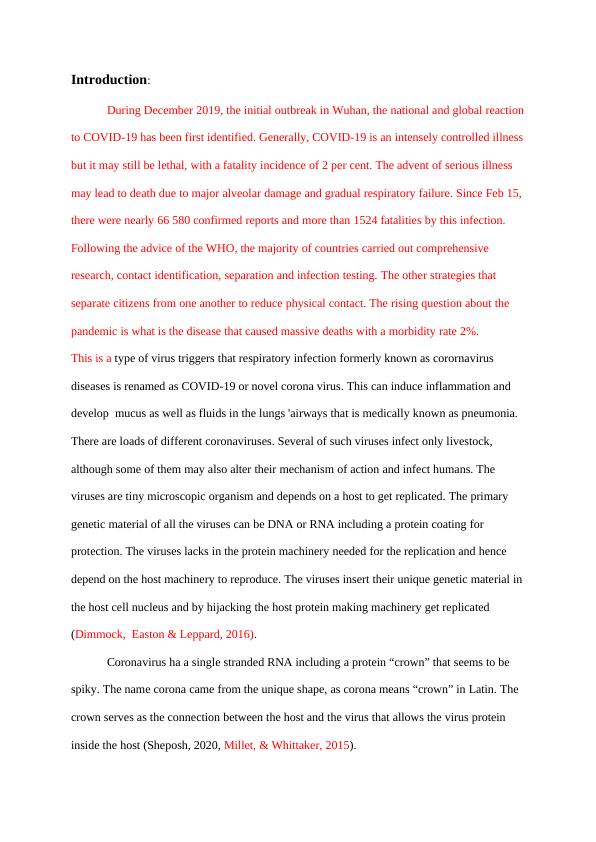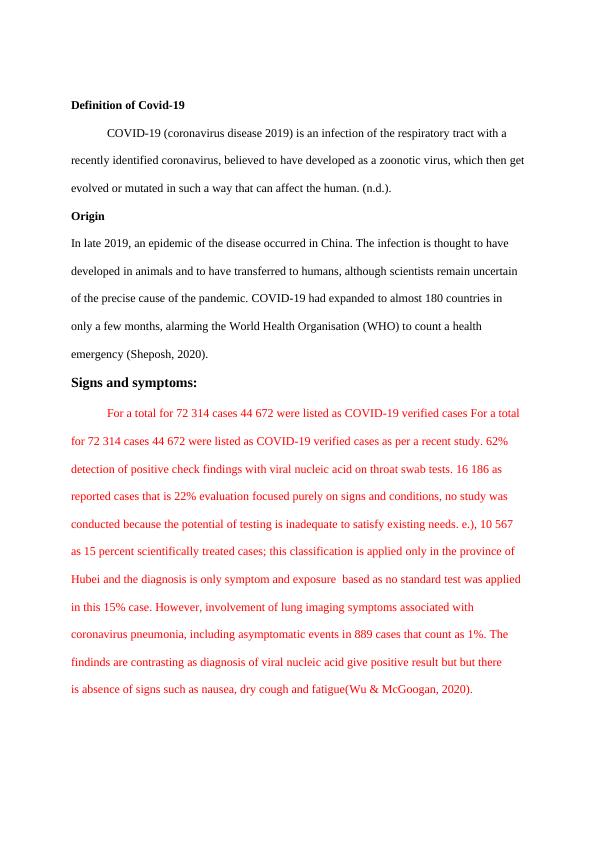Corona Virus (COVID-19) Pandemic | Report
Added on 2022-09-14
9 Pages2473 Words12 Views
Introduction:
During December 2019, the initial outbreak in Wuhan, the national and global reaction
to COVID-19 has been first identified. Generally, COVID-19 is an intensely controlled illness
but it may still be lethal, with a fatality incidence of 2 per cent. The advent of serious illness
may lead to death due to major alveolar damage and gradual respiratory failure. Since Feb 15,
there were nearly 66 580 confirmed reports and more than 1524 fatalities by this infection.
Following the advice of the WHO, the majority of countries carried out comprehensive
research, contact identification, separation and infection testing. The other strategies that
separate citizens from one another to reduce physical contact. The rising question about the
pandemic is what is the disease that caused massive deaths with a morbidity rate 2%.
This is a type of virus triggers that respiratory infection formerly known as corornavirus
diseases is renamed as COVID-19 or novel corona virus. This can induce inflammation and
develop mucus as well as fluids in the lungs 'airways that is medically known as pneumonia.
There are loads of different coronaviruses. Several of such viruses infect only livestock,
although some of them may also alter their mechanism of action and infect humans. The
viruses are tiny microscopic organism and depends on a host to get replicated. The primary
genetic material of all the viruses can be DNA or RNA including a protein coating for
protection. The viruses lacks in the protein machinery needed for the replication and hence
depend on the host machinery to reproduce. The viruses insert their unique genetic material in
the host cell nucleus and by hijacking the host protein making machinery get replicated
(Dimmock, Easton & Leppard, 2016).
Coronavirus ha a single stranded RNA including a protein “crown” that seems to be
spiky. The name corona came from the unique shape, as corona means “crown” in Latin. The
crown serves as the connection between the host and the virus that allows the virus protein
inside the host (Sheposh, 2020, Millet, & Whittaker, 2015).
During December 2019, the initial outbreak in Wuhan, the national and global reaction
to COVID-19 has been first identified. Generally, COVID-19 is an intensely controlled illness
but it may still be lethal, with a fatality incidence of 2 per cent. The advent of serious illness
may lead to death due to major alveolar damage and gradual respiratory failure. Since Feb 15,
there were nearly 66 580 confirmed reports and more than 1524 fatalities by this infection.
Following the advice of the WHO, the majority of countries carried out comprehensive
research, contact identification, separation and infection testing. The other strategies that
separate citizens from one another to reduce physical contact. The rising question about the
pandemic is what is the disease that caused massive deaths with a morbidity rate 2%.
This is a type of virus triggers that respiratory infection formerly known as corornavirus
diseases is renamed as COVID-19 or novel corona virus. This can induce inflammation and
develop mucus as well as fluids in the lungs 'airways that is medically known as pneumonia.
There are loads of different coronaviruses. Several of such viruses infect only livestock,
although some of them may also alter their mechanism of action and infect humans. The
viruses are tiny microscopic organism and depends on a host to get replicated. The primary
genetic material of all the viruses can be DNA or RNA including a protein coating for
protection. The viruses lacks in the protein machinery needed for the replication and hence
depend on the host machinery to reproduce. The viruses insert their unique genetic material in
the host cell nucleus and by hijacking the host protein making machinery get replicated
(Dimmock, Easton & Leppard, 2016).
Coronavirus ha a single stranded RNA including a protein “crown” that seems to be
spiky. The name corona came from the unique shape, as corona means “crown” in Latin. The
crown serves as the connection between the host and the virus that allows the virus protein
inside the host (Sheposh, 2020, Millet, & Whittaker, 2015).

Definition of Covid-19
COVID-19 (coronavirus disease 2019) is an infection of the respiratory tract with a
recently identified coronavirus, believed to have developed as a zoonotic virus, which then get
evolved or mutated in such a way that can affect the human. (n.d.).
Origin
In late 2019, an epidemic of the disease occurred in China. The infection is thought to have
developed in animals and to have transferred to humans, although scientists remain uncertain
of the precise cause of the pandemic. COVID-19 had expanded to almost 180 countries in
only a few months, alarming the World Health Organisation (WHO) to count a health
emergency (Sheposh, 2020).
Signs and symptoms:
For a total for 72 314 cases 44 672 were listed as COVID-19 verified cases For a total
for 72 314 cases 44 672 were listed as COVID-19 verified cases as per a recent study. 62%
detection of positive check findings with viral nucleic acid on throat swab tests. 16 186 as
reported cases that is 22% evaluation focused purely on signs and conditions, no study was
conducted because the potential of testing is inadequate to satisfy existing needs. e.), 10 567
as 15 percent scientifically treated cases; this classification is applied only in the province of
Hubei and the diagnosis is only symptom and exposure based as no standard test was applied
in this 15% case. However, involvement of lung imaging symptoms associated with
coronavirus pneumonia, including asymptomatic events in 889 cases that count as 1%. The
findinds are contrasting as diagnosis of viral nucleic acid give positive result but but there
is absence of signs such as nausea, dry cough and fatigue(Wu & McGoogan, 2020).
COVID-19 (coronavirus disease 2019) is an infection of the respiratory tract with a
recently identified coronavirus, believed to have developed as a zoonotic virus, which then get
evolved or mutated in such a way that can affect the human. (n.d.).
Origin
In late 2019, an epidemic of the disease occurred in China. The infection is thought to have
developed in animals and to have transferred to humans, although scientists remain uncertain
of the precise cause of the pandemic. COVID-19 had expanded to almost 180 countries in
only a few months, alarming the World Health Organisation (WHO) to count a health
emergency (Sheposh, 2020).
Signs and symptoms:
For a total for 72 314 cases 44 672 were listed as COVID-19 verified cases For a total
for 72 314 cases 44 672 were listed as COVID-19 verified cases as per a recent study. 62%
detection of positive check findings with viral nucleic acid on throat swab tests. 16 186 as
reported cases that is 22% evaluation focused purely on signs and conditions, no study was
conducted because the potential of testing is inadequate to satisfy existing needs. e.), 10 567
as 15 percent scientifically treated cases; this classification is applied only in the province of
Hubei and the diagnosis is only symptom and exposure based as no standard test was applied
in this 15% case. However, involvement of lung imaging symptoms associated with
coronavirus pneumonia, including asymptomatic events in 889 cases that count as 1%. The
findinds are contrasting as diagnosis of viral nucleic acid give positive result but but there
is absence of signs such as nausea, dry cough and fatigue(Wu & McGoogan, 2020).

Classified by severity of clinical symptoms of the disease:
Mild disease:
Non-pneumonia and moderate pneumonia which is manifested in 81 per cent of cases
that happened.
Severe disease:
Shortness of breath or dyspenea, the respiratory rate reduces down to lesser than
30/min, PaO2/FiO2 ratio or P/F that is the ratio between the blood pressure of the oxygen
(partial pressure of oxygen, PaO2), the percentage of oxygen supplied (fraction of inspired
oxygen, FiO2)] lesser than 300, and blood oxygen saturation (SpO2) lesser than or equal to
93%, and/or lung infiltrates higher than 50% within the next 24 to 48 hours. This symptoms
found to happen in 14% of the cases.
Critical disease: Myocardial infarction, septic shock, and/or multiple organ dysfunction
(MOD) or failure (MOF); this conditions are manifested in almost 5% of cases (Cascella etl.,
2020).
Statistical analysis of reports of Policy Agencies enable the medical symptoms of the disease
to be separated as per the extent of the medical images.
Location:
A study targeted people of Beijing to understand the effect of geographical location in
the COVID-19 patients. In order to evaluate the clinical and epidemiological features of
COVID-19 in Beijing, data from 262 reported cases were analyzed by the researchers. The
study is primarily based on the findings of quantitate analysis of COVID-19 infection as per
its seriousness. The study concluded that the features of patients diagnosed with COVID-19 in
Beijing clearly varied from those in Wuhan including lesser mortality rate and better
discharge levels, with new diagnosed patients slowly moving from imported to local. Also the
steps for preventing transmission at a preliminary stage were quite promising. By the case
Mild disease:
Non-pneumonia and moderate pneumonia which is manifested in 81 per cent of cases
that happened.
Severe disease:
Shortness of breath or dyspenea, the respiratory rate reduces down to lesser than
30/min, PaO2/FiO2 ratio or P/F that is the ratio between the blood pressure of the oxygen
(partial pressure of oxygen, PaO2), the percentage of oxygen supplied (fraction of inspired
oxygen, FiO2)] lesser than 300, and blood oxygen saturation (SpO2) lesser than or equal to
93%, and/or lung infiltrates higher than 50% within the next 24 to 48 hours. This symptoms
found to happen in 14% of the cases.
Critical disease: Myocardial infarction, septic shock, and/or multiple organ dysfunction
(MOD) or failure (MOF); this conditions are manifested in almost 5% of cases (Cascella etl.,
2020).
Statistical analysis of reports of Policy Agencies enable the medical symptoms of the disease
to be separated as per the extent of the medical images.
Location:
A study targeted people of Beijing to understand the effect of geographical location in
the COVID-19 patients. In order to evaluate the clinical and epidemiological features of
COVID-19 in Beijing, data from 262 reported cases were analyzed by the researchers. The
study is primarily based on the findings of quantitate analysis of COVID-19 infection as per
its seriousness. The study concluded that the features of patients diagnosed with COVID-19 in
Beijing clearly varied from those in Wuhan including lesser mortality rate and better
discharge levels, with new diagnosed patients slowly moving from imported to local. Also the
steps for preventing transmission at a preliminary stage were quite promising. By the case

End of preview
Want to access all the pages? Upload your documents or become a member.
Related Documents
Corona Virus: The Situation in Singapore vs. China Report 2022lg...
|5
|1006
|22
Microbiology: Pathogenicity of Corona Virus Assignment 2022lg...
|3
|620
|18
Promoting health and preventing ill healthlg...
|11
|3555
|93
(PHI 203)-Department of Public Health & Informaticslg...
|10
|2230
|208
Molecular Cell Biology Assignmentlg...
|7
|2030
|15
Impact of Coronavirus on Tourism Sector in the UKlg...
|7
|1933
|444
